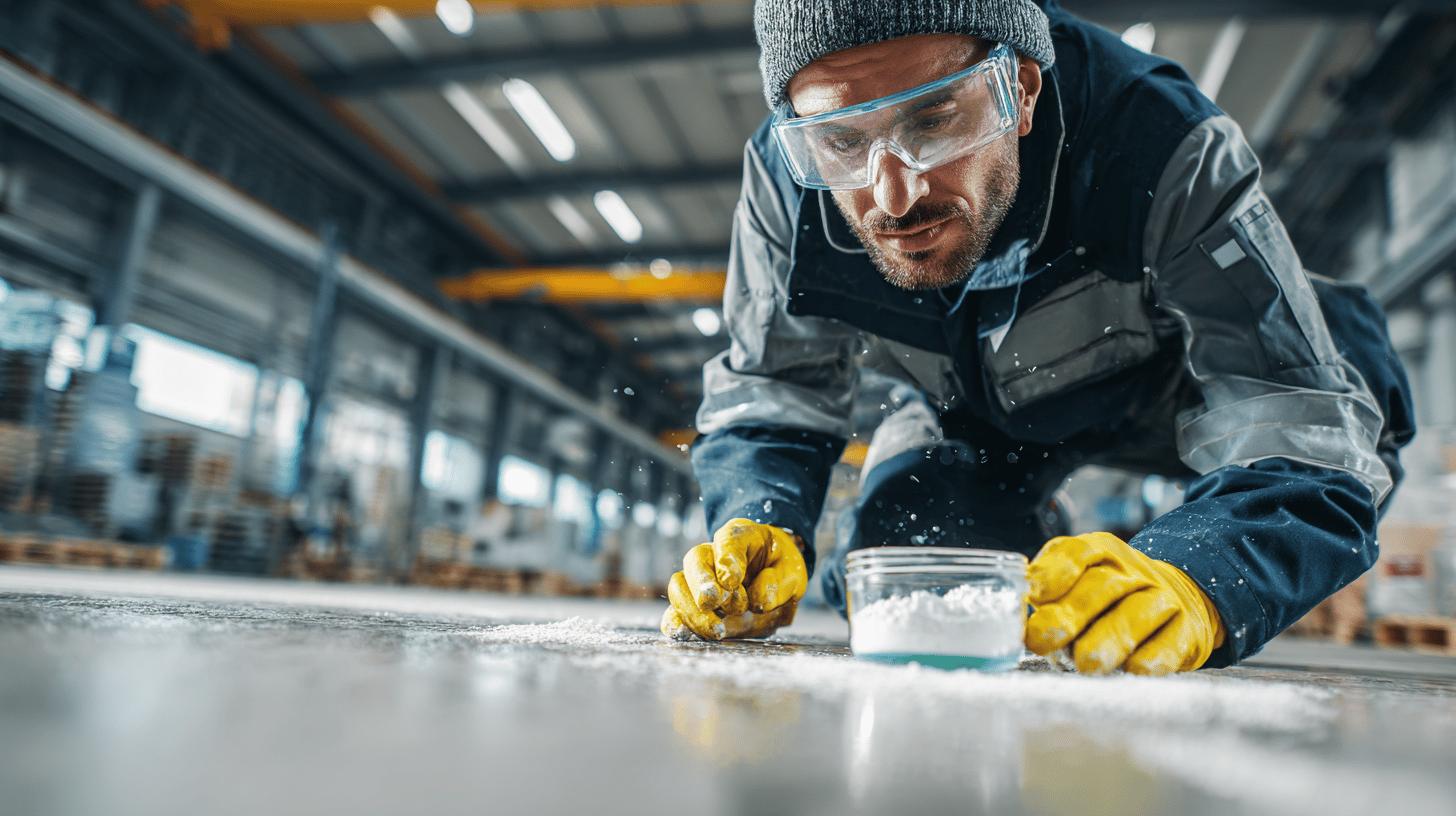Are the floors of your sports facility slipping into decline? The secret weapon to revitalise them might just be traction additives. These game-changing components are crucial for enhancing grip on aging polyurethane (PU) coatings, transforming potentially hazardous surfaces into safe, slip-resistant ones. By increasing the surface roughness, traction additives such as silica, polymer beads, and aluminium oxide act like a fine sandpaper, extending the lifespan of your flooring and boosting safety standards. This article delves into why traction additives are the unsung heroes of flooring maintenance, especially for aging PU coatings. Read on for a grip on how to slip-proof your facility efficiently.
Understanding Traction Additives for PU Coatings
Traction additives, also known as anti-slip additives, are essential for enhancing the grip of floor coatings, specifically polyurethane (PU) coatings. They significantly increase the surface roughness of PU coatings, effectively reducing slip risks and making surfaces safer for regular use.
Common types of traction additives include:
- Silica
- Polymer beads
- Aluminium oxide
- Glass beads
- Crushed walnut shells
.
These additives work by embedding into the surface of PU coatings, creating a textured finish that enhances traction. Silica and aluminium oxide are particularly effective due to their hardness and ability to create a durable, slip-resistant surface. Polymer beads, on the other hand, offer a softer texture, providing moderate slip resistance.
By enhancing the grip of PU surfaces, traction additives play a pivotal role in floor safety. Their application ensures that even aging PU coatings can maintain optimal functionality without the immediate need for replacement. This not only extends the lifespan of the flooring but also ensures a safe environment for users by minimising the potential for slip-related incidents. Regular application of traction additives, therefore, is a proactive measure to maintain safety and performance in high-traffic areas.
The Benefits of Traction Additives on Aging PU Coatings
Traction additives play a crucial role in rejuvenating aging PU coatings by restoring grip and extending the surfaces’ lifespan. As polyurethane coatings age, their initial slip-resistant properties can diminish, leading to safety concerns. By incorporating traction additives, these surfaces can regain their original texture, significantly boosting grip and delaying the need for a complete replacement. This not only enhances safety by reducing slip incidents but also improves the overall durability of the flooring, ensuring it withstands regular wear and tear. Additionally, the application of traction additives can lead to lower maintenance costs, as the need for frequent repairs is minimised.
Utilising traction additives on aging PU coatings offers long-term benefits that extend beyond immediate safety improvements. By maintaining an optimal level of grip, these additives ensure that polyurethane surfaces continue to perform effectively in high-traffic environments. This proactive approach to floor maintenance not only safeguards users but also preserves the aesthetic and functional qualities of the flooring. In the long run, traction additives prove to be a cost-effective solution, enhancing both safety and longevity of PU-coated surfaces.
Application Process of Traction Additives

When applying traction additives to aging PU coatings, there are two primary methods: mixing the additive with the existing floor coating or applying it as a topcoat. Both methods aim to enhance grip and ensure non-slip treatments are effective and long-lasting.
Mixing the additive with the existing coating involves integrating it into the current PU layer, thereby enhancing the floor’s surface texture. Alternatively, applying the additive as a topcoat provides an additional layer of grip enhancement, making it particularly effective for areas with high foot traffic.
Surface Preparation
Proper surface preparation is essential for effective application and longevity of traction additives. Follow these steps:
- Clean the Surface: Remove all dirt, grease, and debris to ensure the additive adheres properly.
- Inspect for Damage: Check for cracks or areas where the coating is peeling and repair them to prevent future issues.
- Dry the Surface: Ensure the floor is completely dry, as moisture can interfere with adhesion.
- Sand the Surface: Lightly sand the surface to create a rougher texture that helps the additive bond effectively.
- Vacuum Dust Particles: After sanding, thoroughly vacuum to remove dust, ensuring a clean surface for application.
.
Application Techniques
The application of traction additives varies based on the chosen method. For mixing with an existing coating, the additive should be evenly distributed within the PU material before application. This method serves as a comprehensive approach, integrating grip enhancement throughout the coating.
When applying as a topcoat, the additive is spread over the prepared surface using rollers or brushes. This technique provides an immediate grip enhancement and is ideal for fast-track projects that require quick drying times.
Regular maintenance checks are crucial to sustain the effectiveness of traction additives. Periodic assessments of the floor condition will identify any areas needing reapplication or additional treatment, ensuring continued safety and optimal performance. These checks also help in identifying early signs of wear, allowing timely interventions to maintain the integrity of the coating.
Effectiveness of Traction Additives: Case Studies and Comparisons
A notable case study within a manufacturing facility demonstrated the efficacy of traction additives in reducing slip incidents and enhancing floor safety. The facility, plagued by frequent slip-related accidents due to aging PU coatings, sought a practical solution to improve traction. After applying traction additives, the facility reported a remarkable 60% reduction in slip incidents within the first three months. This significant decrease not only highlighted the immediate impact of the additives but also underscored their long-term benefits in maintaining a safer working environment.
Expert opinions reinforce the case study’s findings, indicating that traction additives significantly boost slip resistance on aging PU surfaces. Their application enhances the micro-texture of the coatings, providing a more secure grip that effectively mitigates slip risks. These additives also serve to reduce surface wear by fortifying the existing coating, thereby extending its lifespan and minimising the need for frequent maintenance. Facilities that have incorporated traction additives consistently report fewer slip-related incidents and a noticeable improvement in the overall condition of their floors. As a result, traction additives not only enhance safety but also offer a cost-effective solution for prolonging the durability and performance of PU-coated surfaces.
Choosing the Right Traction Additive for Your Needs
Selecting the most suitable traction additive requires careful consideration of several factors, including the type of surface and the desired level of slip resistance. Different traction additives, such as silica, polymer beads, and aluminium oxide, offer varying levels of durability and effectiveness in enhancing grip. When choosing an additive, it’s crucial to assess the specific safety requirements of the environment where it will be applied. For instance, areas with high foot traffic may require additives with higher slip resistance to ensure optimal safety.
Questions to ask when evaluating traction additives:
- What type of surface will the additive be applied to (e.g., concrete, wood, PU)?
- What level of slip resistance is required for the intended environment?
- How durable is the additive, and what is its expected lifespan?
- Are there any specific environmental conditions (e.g., moisture, temperature) that could affect the additive’s performance?
.
Matching the right traction additive to specific safety needs and environments is vital for optimising floor safety and performance. By understanding the unique characteristics and limitations of each additive, property owners can make informed decisions that align with their safety priorities. This tailored approach not only enhances the effectiveness of the grip solutions but also ensures long-term satisfaction by preventing slip-related incidents and maintaining a safe environment.
Final Words
Traction additives play a pivotal role in boosting grip on aging PU coatings, significantly improving safety and durability.
Throughout this exploration, we delved into the types and benefits of these additives and laid out a comprehensive application process.
Case studies underscored their effectiveness in reducing slip incidents.
Selecting the right additive tailored to specific needs proves invaluable for optimising traction and enhancing the lifespan of polyurethane surfaces.
Incorporating traction additives into your floor maintenance strategy ensures safer, more resilient flooring.
Embrace these transformative solutions today for long-term benefits and peace of mind.
Add traction → Epoxy Floor Coatings
FAQ
Q: What are traction additives, and how do they function?
Traction additives, often called anti-slip additives, enhance grip on floor coatings. They increase a surface’s roughness, thereby reducing the risk of slipping. Common types include silica, polymer beads, and aluminium oxide.
Q: How do traction additives benefit aging PU coatings?
Traction additives rejuvenate the grip and extend the lifespan of aging PU coatings, delaying the need for replacement. Benefits include enhanced safety, improved durability, and potentially reduced maintenance costs.
Q: What is the application process for traction additives?
The application of traction additives involves mixing them with existing floor coatings or applying them as a topcoat. Proper surface preparation, such as cleaning and curing, is crucial for longevity and effectiveness.
Q: How effective are traction additives in reducing slip incidents?
Case studies indicate a significant drop in slip-related incidents following the application of traction additives. Before-and-after comparisons show enhanced grip and improved surface conditions.
Q: How do I choose the right traction additive for my needs?
When selecting a traction additive, consider the type of surface, desired slip resistance, and specific safety requirements. Matching the additive to these factors ensures optimal performance and safety.


